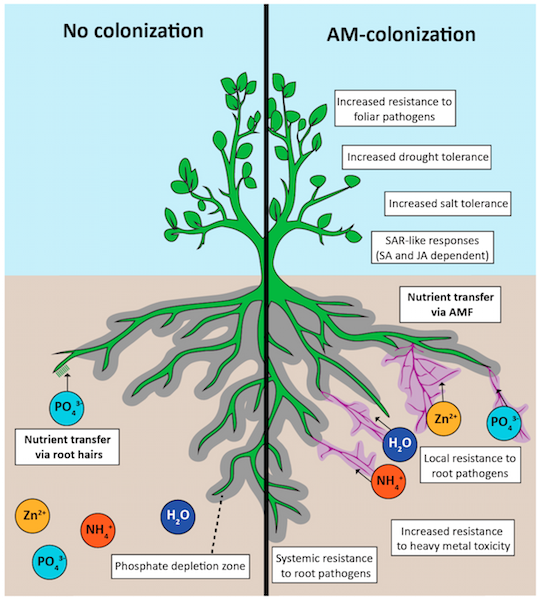Arbuscular Mycorrhizal Fungi
Among the most profuse organisms on this planet, exist arbuscular mycorrhizal fungi. These fungi lie within the Glomeromycota phylum, and form mutualistic symbiosis with the roots of most vascular plants. These fungi thrive in mostly every region and area of the earth, influencing nutrient uptake for the plants that they surround. Analysis of the molecular structure, along with studies and reports of fossilized fungal material, lead scientists to believe that the AMF derived with the first terrestrial plants. Because of this, it is thought that that symbiotic relationship between the mycorrhizal fungi and plants may have been necessary for the adjustment of plants to the above ground environment from the Ordovician era. [5]

How do the AMF and plants link?:
Arbuscular mycorrhizal fungi subsist essentially as microscopic filaments called hyphae. The mycorrhizal fungi spore germinates asexually in the soil and makes their approach to the nearby roots; which get populated by the fungi, thus establishing mycorrhiza. When the fungi infiltrate the root, it creates an internal system of fungal structures within the root cells. Hyphae advance outside of the root, establishing a largely extensive network of fine fibers. This will pull in additional nutrients and water for the plant. These hyphae are articulated in a web like structure called mycelium. The mycelium is packed tightly around the roots and can extend outward toward other plants, to connect to their mycorrhizae as well. This new network can connect plants of different species from across the field/forest/jungle/garden etc.
The Symbiotic Relationship:
Arbuscular Mycorrhizal fungi are shown to demonstrate and enhance community make-up, plant strength, diversity, and ecosystem performance. Nevertheless, plant systems have been recognized to affect the variety and composition of AMF as well. [7] AMF can transfer water to the plant, increase resistance to root pathogens and toxic metals, and get inadequately soluble nutrients (such as phosphorous, copper, and zinc) from the soil to the plant. In turn, the plant provides carbohydrates to the fungus. AMF are obligate biotrophs, depending on living root tissue for carbohydrate supply to complete their asexual life cycle. [4] Conditions that severely limit agricultural growth in some parts of the world, such as low water availability, are aided by this mutualistic symbiotic relationship, and is most likely necessary for optimal growth. [3]
|
Figure #1: “Positive effects of arbuscular mycorrhizal colonization. The hyphal network of arbuscular mycorrhizal fungi extends beyond the depletion zone (grey), accessing a greater area of soil for phosphate uptake. A mycorrhizal-phosphate depletion zone will also eventually form around AM hyphae (purple). Other nutrients that have enhanced assimilation in AM-roots include nitrogen (ammonium) and zinc. Benefits from colonization include tolerances to many abiotic and biotic stresses through induction of systemic acquired resistance (SAR).” [2] |
References:
[1] Coleman, D. C., Crossley, D. A., Jr., & Hendrix, P. F. (2004). Fundamentals of Soil Ecology (2nd ed.). Amstherdan: Elsevier.
[2] Jacott, C., Murray, J., & Ridout, C. (2017). Trade-Offs in Arbuscular Mycorrhizal Symbiosis: Disease Resistance, Growth Responses and Perspectives for Crop Breeding. Agronomy,7(4), 75. doi:10.3390/agronomy7040075
[3] Kosuta, S. (2003). A Diffusible Factor from Arbuscular Mycorrhizal Fungi Induces Symbiosis-Specific MtENOD11 Expression in Roots of Medicago truncatula. Plant Physiology,131(3), 952-962. doi:10.1104/pp.011882
[4] Paszkowski, U. (2006). A journey through signaling in arbuscular mycorrhizal symbioses 2006. New Phytologist,172(1), 35-46. doi:10.1111/j.1469-8137.2006.01840.x
[5] Rosendahl, S. (2008). Communities, populations and individuals of arbuscular mycorrhizal fungi. New Phytologist,178(2), 253-266. doi:10.1111/j.1469-8137.2008.02378.x
[6] Treseder, K. K., & Cross, A. (2006). Global Distributions of Arbuscular Mycorrhizal Fungi. Ecosystems,9(2), 305-316. doi:10.1007/s10021-005-0110-x
[7] Velázquez, M. S., Cabello, M. N., & Barrera, M. (2013). Composition and structure of arbuscular-mycorrhizal communities in El Palmar National Park, Argentina. Mycologia,105(3), 509-520. doi:10.3852/11-353
